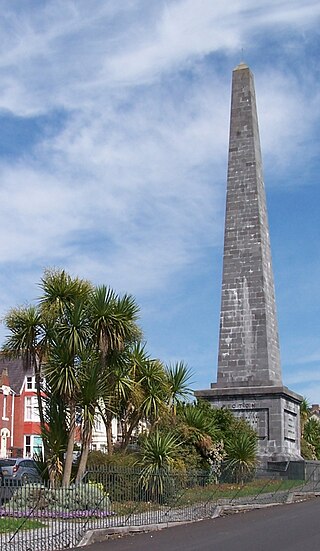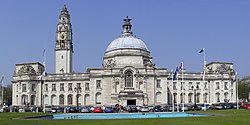
Lieutenant-General Sir Thomas Picton was a British Army officer who fought in the Napoleonic Wars. According to the historian Alessandro Barbero, Picton was "respected for his courage and feared for his irascible temperament". The Duke of Wellington called him "a rough foul-mouthed devil as ever lived", but found him capable.

Carmarthen is the county town of Carmarthenshire and a community in Wales, lying on the River Towy 8 miles (13 km) north of its estuary in Carmarthen Bay. The population was 14,185 in 2011, down from 15,854 in 2001, but gauged at 16,285 in 2019. It has a claim to be the oldest town in Wales – Old Carmarthen and New Carmarthen became one borough in 1546. It was the most populous borough in Wales in the 16th–18th centuries, described by William Camden as "chief citie of the country". Growth stagnated by the mid-19th century as new settlements developed in the South Wales Coalfield.

The Welsh National Temple of Peace and Health, known as the Temple of Peace and Health or commonly the Temple of Peace, is a non-religious civic building in Cathays Park, Cardiff, the capital city of Wales. It was designed by the architect Sir Percy Thomas. Since its foundation, the building has served a dual function as headquarters for health and international affairs organisations.

National Museum Cardiff is a museum and art gallery in Cardiff, Wales. The museum is part of the wider network of Amgueddfa Cymru – Museum Wales. Entry is kept free by a grant from the Welsh Government.

Cathays Park or Cardiff Civic Centre is a civic centre area in the city centre of Cardiff, the capital city of Wales, consisting of a number of early 20th century buildings and a central park area, Alexandra Gardens. It includes Edwardian buildings such as the Temple of Peace, City Hall, the National Museum and Gallery of Wales and several buildings belonging to the Cardiff University campus. It also includes Cardiff Crown Court, the administrative headquarters of the Welsh Government, and the more modern Cardiff Central police station. The Pevsner architectural guide to the historic county of Glamorgan judges Cathays Park to be "the finest civic centre in the British Isles". The area falls within the Cathays electoral ward.

Belfast City Hall is the civic building of Belfast City Council located in Donegall Square, Belfast, Northern Ireland. It faces North and effectively divides the commercial and business areas of the city centre. It is a Grade A listed building.

Wales in the Late Middle Ages spanned the years 1282–1542, beginning with conquest and ending in union. Those years covered the period involving the closure of Welsh medieval royal houses during the late 13th century, and Wales' final ruler of the House of Aberffraw, the Welsh Prince Llywelyn II, also the era of the House of Plantagenet from England, specifically the male line descendants of Geoffrey Plantagenet, Count of Anjou as an ancestor of one of the Angevin kings of England who would go on to form the House of Tudor from England and Wales.

Dyffryn Gardens, also spelt Duffryn Gardens, is a collection of botanical gardens located near the villages of Dyffryn and St. Nicholas in the Vale of Glamorgan, Wales. The gardens were selected by the British Tourist Authority as one of the Top 100 gardens in the UK and are in the care of the National Trust. They are designated at Grade I, the highest grade, on the Cadw/ICOMOS Register of Parks and Gardens of Special Historic Interest in Wales.

Sir William Goscombe John was a prolific Welsh sculptor known for his many public memorials. As a sculptor, John developed a distinctive style of his own while respecting classical traditions and forms of sculpture. He gained national attention with statues of eminent Victorians in London and Cardiff and subsequently, after both the Second Boer War and World War I, created a large number of war memorials. These included the two large group works, The Response 1914 in Newcastle upon Tyne and the Port Sunlight War Memorial which are considered the finest sculptural ensembles on any British monument.

Sir Percy Edward Thomas OBE was an Anglo-Welsh architect who worked in Wales for the majority of his life. He was twice RIBA president.

Sir Alfred Brumwell Thomas was an English architect who trained at Westminster School of Art and became an exponent of the Baroque Revival, a style of architecture prevalent for public buildings in the early years of the 20th century.

The Glamorgan Building is a former county hall located at King Edward VII Avenue in Cathays Park, Cardiff, Wales. It was the headquarters of Glamorgan County Council from 1912 to 1974 and then of Mid Glamorgan County Council from 1974 to 1996. The building, which was acquired by Cardiff University in 1997 and is now home to the university's School of Social Sciences and the School of Geography and Planning, is a Grade I listed building.

Cardiff Crown Court is a historic building situated in Cathays Park, Cardiff, Wales. The building is a Grade I listed building. As a Crown Court venue it is part of the Wales Circuit of His Majesty's Courts and Tribunals Service. The court house has nine courtrooms in addition to one "virtual" courtroom. The senior judge at the court is Judge Tracey Lloyd-Clarke, the Recorder of Cardiff.

Edwardian architecture usually means a Neo-Baroque architectural style that was popular for public buildings in the British Empire during the Edwardian era (1901–1910). Architecture up to the year 1914 may also be included in this style.

Architecture in Cardiff, the capital city of Wales, dates from Norman times to the present day. Its urban fabric is largely Victorian and later, reflecting Cardiff's rise to prosperity as a major coal port in the 19th century. No single building style is associated with Cardiff, but the city centre retains several 19th and early 20th century shopping arcades.

Percy Thomas Partnership was the trading name of the award-winning British architectural practice established some time between 1965 and 1973 as the successor to a series of earlier partnerships originally set up by Percy Thomas (1883–1969) in Cardiff, Wales in 1911/12. Percy Thomas and the Percy Thomas Partnership put their name to a number of landmark buildings in the United Kingdom including the Wales Millennium Centre, Cardiff. It opened offices overseas and completed a number of prestigious buildings in Hong Kong.

Caernarfon Castle is a medieval fortress in Gwynedd, north-west Wales. The first fortification on the site was a motte-and-bailey castle built in the late 11th century, which King Edward I of England began to replace with the current stone structure in 1283. The castle and town established by Edward acted as the administrative centre of north Wales, and as a result the defences were built on a grand scale. There was a deliberate link with Caernarfon's Roman past—nearby is the Roman fort of Segontium—and the castle's walls are reminiscent of the Walls of Constantinople.

A number of statues and memorials have been the subject of protests and petitions during the George Floyd protests in the United Kingdom in 2020.
Ivan Dale Owen was a Welsh architect in the modernist architectural style. The Glamorgan Archives and The Independent newspaper both described him as a 'leading figure in Welsh architecture'. He was a partner in the Percy Thomas Partnership before setting up his own architectural practice with his wife in Penarth in 1989. Among Owen's designs were BBC Broadcasting House, Cardiff, the entrance building and galleries of St Fagans National Museum of History, Cardiff, plus major developments at Cardiff University, Swansea University and Aberystwyth University.

The Picton Monument in Carmarthen, Wales, is one of a number of memorials commemorating Lieutenant General Sir Thomas Picton. He was the highest ranking British officer to die at the Battle of Waterloo in 1815. Picton was from Haverfordwest, Pembrokeshire. At the time of his death he had a property called Iscoed in Carmarthenshire.






























